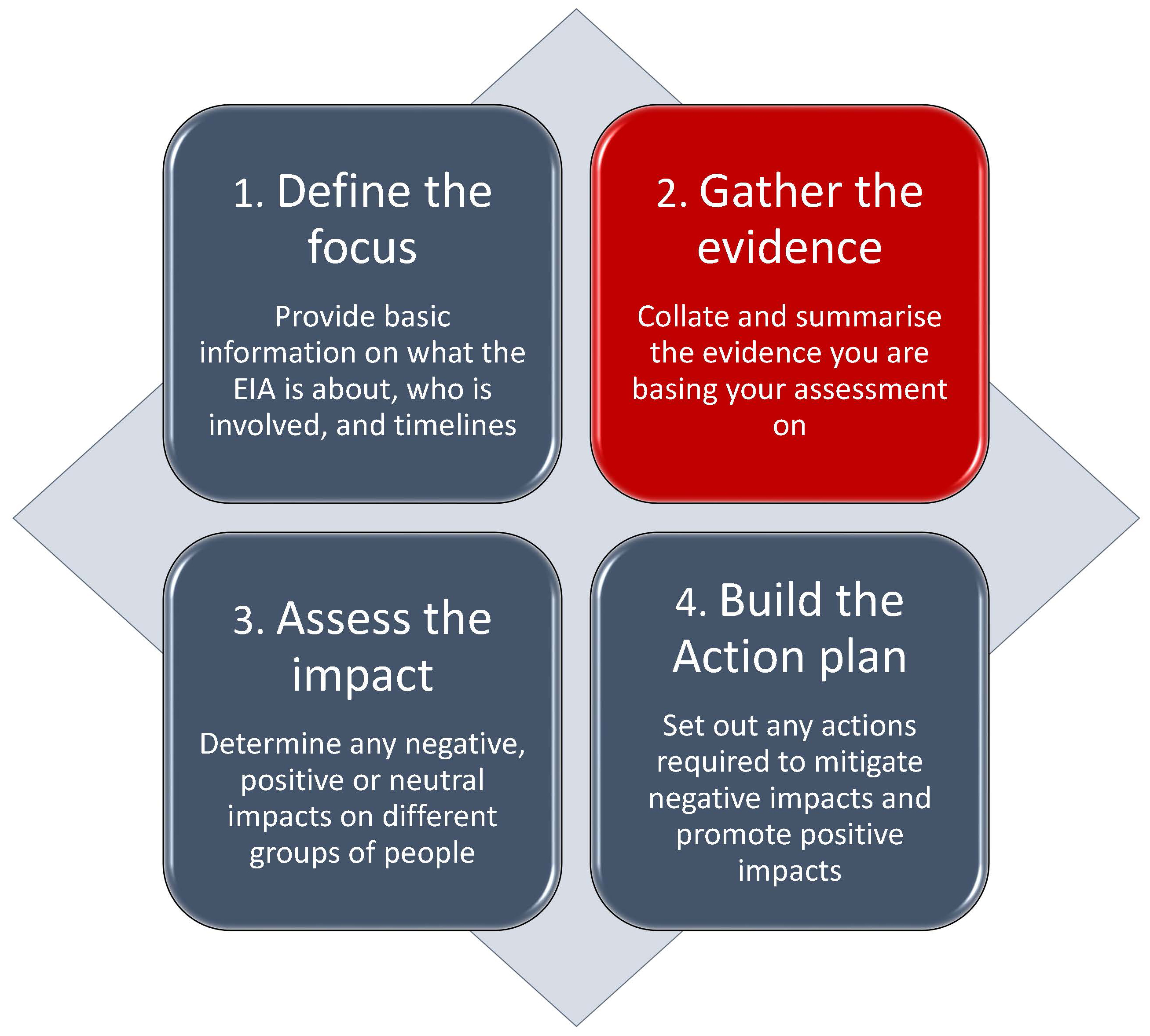EIA Stage 2: Gather the evidence


In Stage 2 you gather relevant information to enable you to evaluate if what the EIA is about is likely to, and/or has previously had, a positive, negative or neutral impact on particular groups of people
The EIA process adopts an evidence-based approach. The type of evidence needed, and the way it is obtained, will vary. It is important to apply a method that is appropriate and proportionate. Examples of evidence may include:
- Data (qualitative and quantitative) already available or produced for the purpose of the EIA exercise
- Research and publications
- Consultation with relevant groups including staff support networks, EDI Committees, Student Union, for instance
It is vital that you consider the type of evidence you might need and how it relates to the protected characteristics that are likely to be affected by your policy / process / activity / change.
Consultation can be very important to understanding the lived experience of protected groups and how your policy / process / activity / change may affect them. You can consult in a number of different ways (e.g. focus groups, surveys, interviews). You should make sure your consultation is proportionate to the size and scope of your policy / process / activity / change.
Consider your timescales and how your consultation can fit into them, to ensure you meet any deadlines.
You should summarise the information sources you have used and any consultation you have undertaken, along with the key findings from this that are relevant to EDI – what the information told you. If you have a lot of information, it can be helpful to include this as a separate document as an appendix.
Bear in mind that to protect anonymity, you should not report numbers for any group that are less than 5, or percentages based on less than 5 people, which may mean you have to leave figures out for some groups. Instead, you can say ‘less than 5’ or suppress (don’t provide) the numbers.
How can you collect evidence to complete your EIA?
A wide range of evidence may be relevant to your EIA. Please contact the EDI team to get advice on the best evidence to use, if you are unsure. Examples include:
- Colleague and/or student diversity profile and study or employment related data, as appropriate to what the EIA is about. For example: data on who is affected/who it applies to and their protected characteristics; course or study-related data by protected characteristic, such as level of study, programme of study, retention or degree outcomes; employment data by protected characteristic, such as job families, part-time/full-time, fixedterm/permanent, grade, salary.
- Take-up/usage data by different groups – where available, data on who has used or participated in the service, policy, system, project etc. in question, by protected group where possible (you will likely not have information on all the protected characteristics but look for as much as you can).
- Comparator/benchmarking data (internal or external) – comparing your data with benchmarking data can help to reveal if there are low or high numbers of a particular group in your population in question (e.g. if a service or policy is being used by a higher proportion of women than are in the student/colleague population overall this may indicate barriers to uptake by men). You may find it helpful to compare any colleague data you have with the University-wide situation shown in our Lincoln Annual EDI Report.
- Survey results – draw on findings of any available surveys as appropriate to the EIA and pull out anything specific to any particular groups, if you can.
- Feedback, consultation and anecdotal evidence – you can draw on information received from colleagues or students that is relevant to what the EIA is about. For example, feedback gathered through evaluation activities, surveys or focus groups, or provided in meetings. The knowledge and experience of colleagues working in a relevant area or who have implemented this or similar approaches in the past is also useful evidence (see below for more information on consultation).
- Reports of discrimination, harassment, victimisation, complaints, concerns or grievances – where relevant to the EIA and available, include information about these (anonymised).
- Findings of research/reports – external evidence sources are particularly useful when there are gaps in our internal evidence or to supplement our own evidence. There are many published reports on EDI in UK HE that can be cited, and relevant findings summarised to support the analysis.
Consultation
It is recommended that, wherever feasible, you consult/engage people affected by what your EIA is about or people who can provide insight into the possible impacts for different groups, in order to understand different experiences and needs, and how the policy/process/activity/change may affect different groups. This is particularly important when there is a lack of existing data or evidence or if there is any indication that there may be negative implications for any group(s).
Summarise the main issues highlighted in the consultation. A full report is not required. If there is concern that there may be negative impact with regard to one or more protected characteristics, this should be captured in the action plan (Stage 4).
You will need to identify the most relevant and proportionate means of consultation. Sometimes a more thorough approach is needed, while at other times consulting a relevant committee or group and/or some relevant individuals will be sufficient. This guidance relating to relevance and proportionality can help you decide on the scale of consultation required.
Who should you consult?
It will depend on what the EIA is about and who it affects. For employment related changes, you need to consult those whose employment will be affected, and consideration of EDI should be built into this process. For policies, projects and strategies affecting all or large groups of students or colleagues, a broader approach is needed. Suggestions are provided below:
Forums/groups for consultation include:
- Eleanor Glanville Institute – for consultation on matters that affect the whole University or large groups of people and when EDI impacts are expected/likely. Please contact the EGI to discuss.
- EDI Forum – for matters affecting the whole university or large groups of people and when EDI impacts are expected/likely. Items can be brought to the EDI Forum, either through thr EGI, School/Department/College EDI Committees, or staff support networks.
- College EDI Committees – for matters affecting large groups of people and when EDI impacts are expected/likely within particular Colleges.
- School/Department EDI Committees – for consultation on matters relating to a particular school / Department.
- ULSU sabbatical officers – for matters relating to students.
- Colleague and PGR EDI networks - for consultation on matters that affect particular protected characteristic groups. Please contact the EGI to discuss if you would like to consult a network.
Suggestions for how to consult:
- Gather feedback and experiences from students/colleagues affected e.g. through listening sessions, meetings, interviews, surveys or focus groups. Contact the EGI for support.
- Send or present the draft of your policy, strategy, or plan etc. to relevant people/groups and ask for comments on how it may impact them or those from particular groups in a positive or negative way.
- Ask former users of the policy, procedure, or service etc. for their experiences of using it.
- Refer to already available consultation data/results/findings your team/unit holds, including for something related but not exactly the same.
- Ensure future surveys and other feedback mechanisms relating to the area ask relevant questions to assist you with future EIAs.
To help you with your consultation, here is a simple guide to ask questions effectively:
- Avoid closed questions (yes/no)
- Open-ended questions are preferred to allow people to express their opinions (e.g. "Can you tell me about…; How do you feel about…; What do you think about…")
- One question at the time
- Keep it short
- Avoid jargon and complex language
- Ask about things that are not clear to you ("Could you tell me what you mean by that? ...Can you give me an example…").
What if there are gaps in your evidence?
You are unlikely to have all the information you would ideally want, but the important thing is to make best use of the information you have. Decisions will need to take into account information deficiencies and reach the best judgement possible using what is available.
Where there are significant gaps in the information available that limit the EIA, consultation can help you to fill them. You may still be left with gaps, which you should note in the EIA and where possible identify how you will seek to address this in your plan at Stage 4. This may include further engagement activity to gather feedback or changes to data collection or monitoring going forward to gather more information. Any new information you obtain should be used to update the EIA, and any actions that are required.
Timing and confidentiality
- Remember to provide enough time for consultation, bearing in mind that some individuals (e.g. staff support network members) will likely be providing feedback in their own time and not as part of their job.
- For all consultation you should ensure confidentiality of responses and do not name individuals in the EIA document without their consent.




